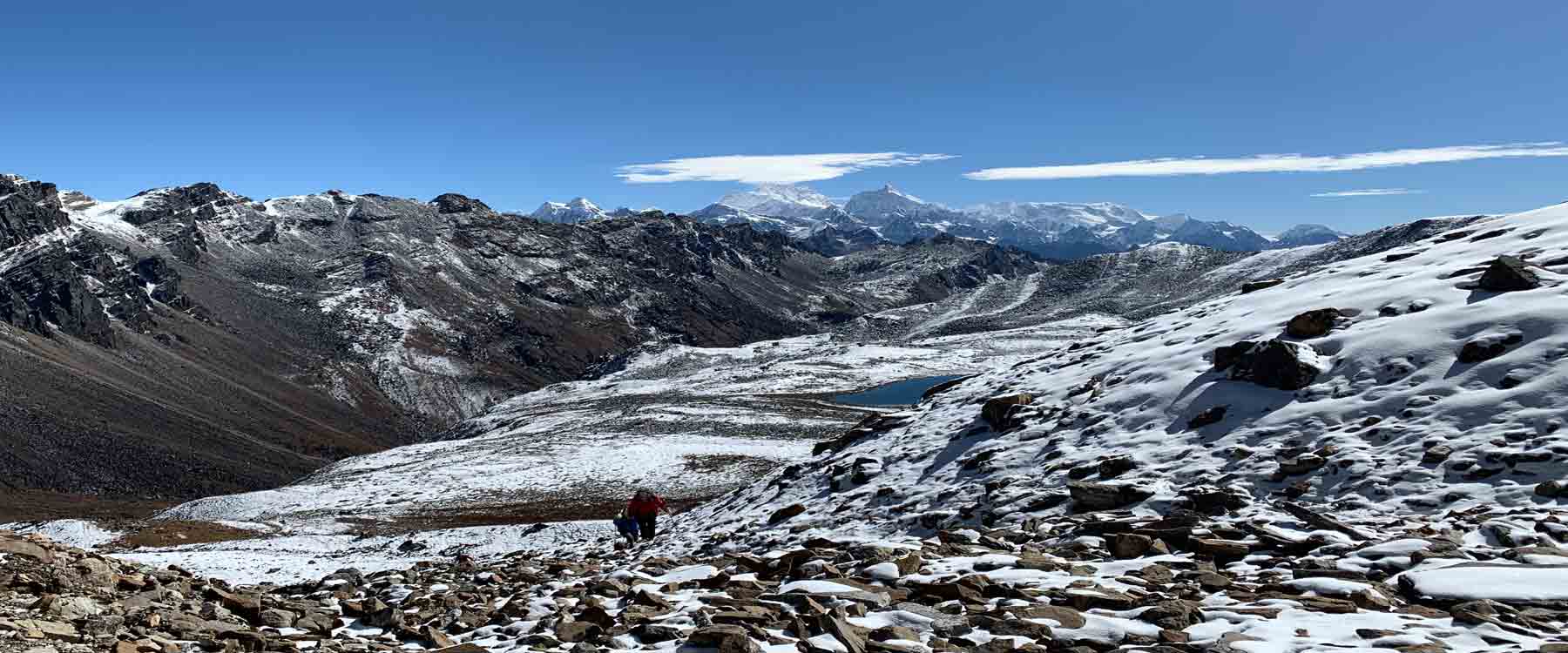- info@mountadventureholidays.com
- +977 - 9843746611

The Kanchenjunga Base Camp Trek is a stunning and challenging trek in the eastern Himalayas, offering breathtaking views of the world's third-highest mountain, Kanchenjunga.
Enjoy Scenic Views: The Kanchenjunga region is renowned for its exceptional natural beauty. Take your time to soak in the breathtaking views of snow-capped peaks, pristine valleys, cascading waterfalls, and dense rhododendron forests.
Explore Local Culture: Interact with the local communities inhabiting the region, such as the Sherpas and Limbus, to learn about their unique culture, traditions, and way of life. Visit monasteries and witness religious ceremonies to get a glimpse into the spiritual aspects of the region.
Trek to Kanchenjunga Base Camp: The ultimate goal of the trek is to reach the Kanchenjunga Base Camp. This is a challenging endeavor that rewards you with a close-up view of the majestic Kanchenjunga massif. The base camp sits at an altitude of approximately 5,143 meters (16,873 feet) and offers an unforgettable experience.
Visit Pangpema: Pangpema is another popular destination during the Kanchenjunga Base Camp Trek. It is located near the Kanchenjunga North Base Camp and provides stunning panoramic views of the mountain range. This place is perfect for photography enthusiasts.
Explore Yalung Glacier: The Yalung Glacier is the fifth-longest glacier in the world and is located in the Kanchenjunga region. You can take a detour to explore this magnificent glacier, which is surrounded by towering peaks and pristine beauty.
Observe Wildlife: The Kanchenjunga Conservation Area is home to a diverse range of flora and fauna. Keep an eye out for unique wildlife species such as the elusive snow leopard, red panda, Himalayan black bear, and a variety of bird species. It's a fantastic opportunity for nature enthusiasts and wildlife photographers.
Cross High Passes: The Kanchenjunga Base Camp Trek involves crossing several high passes, such as the Mirgin La Pass and Sinion La Pass. These challenging sections of the trek offer exhilarating experiences and incredible panoramic views of the surrounding landscapes.
Enjoy Local Cuisine: Taste the local delicacies and traditional cuisine of the region. Try dishes like momo (dumplings), thukpa (noodle soup), gundruk (fermented leafy greens), and other authentic Himalayan dishes. It's a great way to experience the local culture through food.
What is the best season to visit the Kanchenjunga base camp Trek?
The best season to visit the Kanchenjunga Base Camp Trek is during the pre-monsoon (spring) and post-monsoon (autumn) seasons. These seasons provide the most favorable weather conditions for trekking in the region.
Spring (March to May): Spring is an excellent time to undertake the Kanchenjunga Base Camp Trek. The weather is generally stable, with clear skies and moderate temperatures. The beautiful rhododendron forests along the trail are in full bloom during this time, adding vibrant colors to the landscape. However, be prepared for occasional showers and be aware that the higher altitudes may still have snow.
Autumn (September to November): Autumn is another popular season for the Kanchenjunga Base Camp Trek. The weather is generally dry and stable, providing clear visibility of the mountain peaks. The temperatures are pleasant during the day, making it comfortable for trekking. The autumn season also offers breathtaking views of the surrounding landscapes, and the forests exhibit stunning hues as the leaves change colors. It is generally considered the best time for trekking in the region.
How much cost and permit for this Kanchenjunga Base Camp Trek?
The cost and permits for the Kanchenjunga Base Camp Trek can vary depending on several factors, such as the duration of the trek, the services included, and whether you choose to go independently or through a trekking agency. Here are some general guidelines:
Trekking Permits: To trek in the Kanchenjunga region, you will need two permits: the Kanchenjunga Restricted Area Permit and the Kanchenjunga Conservation Area Permit. These permits are required to enter the restricted area and contribute to the conservation efforts in the region. The cost of these permits can vary but is typically around USD 20-30 per person per week.
TIMS Card: The Trekker's Information Management System (TIMS) card is also required for the Kanchenjunga Base Camp Trek. It helps track and ensure the safety of trekkers. The cost of a TIM card is approximately USD 20 per person.
Guide and Porter Fees: If you choose to hire a guide and/or porter, their fees will add to the overall cost of the trek. Hiring a guide is highly recommended, as they are familiar with the region, can assist with navigation, and provide valuable insights. The guide fees can range from USD 20-30 per day. Similarly, porter fees vary, but they generally cost around USD 15-25 per day.
Accommodation and Meals: The cost of accommodation and meals will depend on the type of lodging you choose and the services provided. Tea houses and lodges are available along the trekking route, offering basic facilities. The cost of accommodation can range from USD 5-20 per night. Meals will cost around USD 5-15 per meal, depending on the menu and location.
Transportation: The cost of transportation to and from the trekking starting point will depend on your mode of travel and distance. Whether you choose to fly or take a bus or jeep, it's advisable to factor in the transportation costs when planning your budget.
It's essential to note that these are approximate costs, and prices can vary depending on the current economic situation and individual preferences. Additionally, hiring a trekking agency can simplify the logistics but may increase the overall cost. It's advisable to research and compare prices from different agencies and make an informed decision based on your requirements and budget.
© Copyright 2025 Mount Adventure Holidays ,All rights reserved. | Developed by : Web Design In Nepal